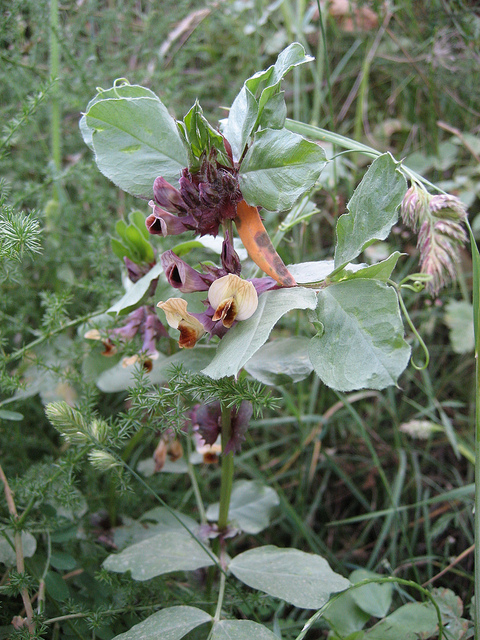Faba bean
Vicia faba
Faba bean (Vicia faba) is the third most important legume grain after soybean and pea. It is widely cultivated around the world for the dried and fresh beans, for animal fodder and as a green manure. It is used for human consumption in the Mediterranean region, the Middle East, China, Ethiopia and Latin America.
Although classified in the same genus as the vetches (Vicia), some botanists argue that the species should be included in a separate monotypic genus, Faba.
No wild progenitor of faba bean has been identified and the species does not produce fertile hybrids with any other Vicia species. The plant differs from most other vetches in that the leaves do not have tendrils for climbing. The pods are green, broad and leathery. When mature they are blackish-brown with a dense, downy surface.
Faba bean is diploid (2n=12) and partly out-crossing, with cross-pollination ranging from 8% to 84% and an average of 35%.
Three distinct types, based on seed size, are commonly recognized:
- large-seeded variety major
- intermediate variety equina
- small-seeded variety minor
Collecting
Collecting Projects
Faba bean is considered one of the world’s oldest crops. Its cultivation probably originated in the Southern Levant around 10200 BP. From there, the crop spread to Central Europe, Russia, the Mediterranean coast, Abyssinia, China and India. The Spaniards introduced it to the New World in the 16th century. Later, during the 20th century, the crop reached Australia.
Collections
The most important collection is the one held at the International Centre for Agricultural Research in Dry Areas (ICARDA) with 10,000 accessions. Other large collections are held by the Australian Grains Genebank, the Leibniz Institute of Plant Genetics and Crop Plant Research in Germany and the N.I. Vavilov Research Institute of Plant Industry in Russia.
Genesys displays information for more than 11,000 faba bean accessions.
A series of consultations, surveys and workshops were carried out between 2005 and 2008 to prepare the global strategy for the ex situ conservation of faba bean.
COLLECTING PARTNERS
- Armenian Botanical Society (ABS)
- Lebanon Agricultural Research Institute (LARI)
- Museu Nacional de História Natural e da Ciéncia
- University of Pavia
- Genetic Resources Institute (GRI) of Azerbaijan National Academy of Sciences
- Agricultural Research Institute (ARI) of the Ministry of Agriculture, Natural Resources of Environment
- National Botanical Garden of Georgia (NBGG)
- Spanish Institute for Agricultural and Food Research and Technology (INIA, Spain)

